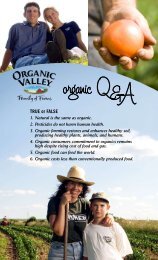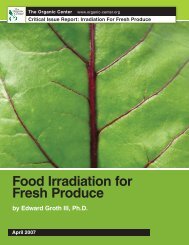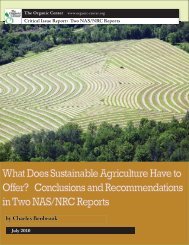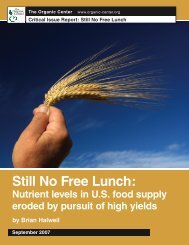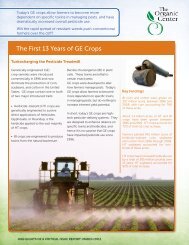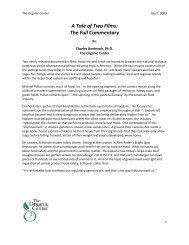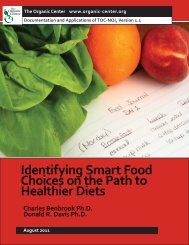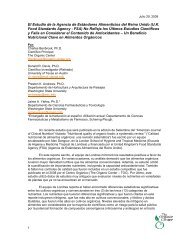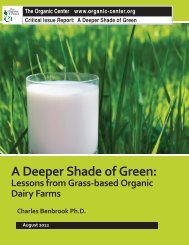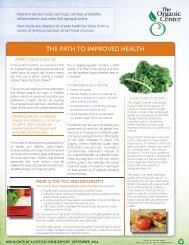Organic Food Production Talking Points - Hunger and ...
Organic Food Production Talking Points - Hunger and ...
Organic Food Production Talking Points - Hunger and ...
You also want an ePaper? Increase the reach of your titles
YUMPU automatically turns print PDFs into web optimized ePapers that Google loves.
<strong>Hunger</strong> <strong>and</strong> Environmental Nutrition DPG<br />
<strong>Organic</strong> <strong>Food</strong> <strong>Production</strong> <strong>Talking</strong> <strong>Points</strong><br />
<strong>Hunger</strong> <strong>and</strong> Environmental Nutrition<br />
Dietetic Practice Group of the<br />
American Dietetic Association<br />
www.HENdpg.org<br />
Mission: ! Leading the future in sustainable <strong>and</strong> accessible food <strong>and</strong> water<br />
systems through dietetics education, research, <strong>and</strong> action.<br />
Vision:<br />
!HEN members are the most valued source of nutrition services to<br />
promote access to nutritious food <strong>and</strong> clean water from a secure<br />
<strong>and</strong> sustainable environment.<br />
May 2006<br />
Revised April 2007<br />
<strong>Organic</strong> <strong>Food</strong> <strong>Production</strong> <strong>Talking</strong> <strong>Points</strong> - April 2007! ! ! 1
<strong>Hunger</strong> <strong>and</strong> Environmental Nutrition DPG<br />
Introduction<br />
<strong>Organic</strong> food is the fastest growing segment of the food industry. More organic food is entering the mainstream food<br />
distribution system <strong>and</strong> consumers are becoming interested in the origins of their food. They are asking more<br />
sophisticated questions <strong>and</strong> searching for information about the food supply from food <strong>and</strong> nutrition professionals.<br />
The purpose of this document is to provide food <strong>and</strong> nutrition professionals, ADA Media Representatives <strong>and</strong><br />
Spokespersons with information that they can utilize to speak knowledgeably about organic food production when<br />
speaking with the news media. <strong>Organic</strong> foods are products of a holistic system that is closely regulated <strong>and</strong> monitored by<br />
law:<br />
• <strong>Organic</strong> <strong>Food</strong>s <strong>Production</strong> Act of 1990, Public Law 101-624 (http://agriculture.senate.gov/Legislation/<br />
Compilations/AgMisc/OGFP90.pdf).<br />
Water, soil <strong>and</strong> air quality, environmental preservation <strong>and</strong> enhancement, biodiversity, humane animal treatment, safety<br />
for farm labor, <strong>and</strong> energy conservation are all integral to an organic system. Nutrition is one component of the system<br />
<strong>and</strong> an emerging area of research in this field.<br />
The information in this document is presented in two forms. Following the introduction there is a user friendly single page<br />
of concise talking points drawn from the research. The talking points are divided into information about organic farming<br />
systems that have a large body of research followed by information about areas that require further research. The second<br />
section contains more detailed explanations <strong>and</strong> specific annotated references to the literature that support the basic<br />
concepts presented in the talking points.<br />
This document was prepared by an Ad Hoc committee of members from the <strong>Hunger</strong> <strong>and</strong> Environmental Nutrition DPG#15<br />
(www.hendpg.org):<br />
• Helen Costello, MS, RD, LD, 2006-2007 HEN DPG Chair<br />
• Mary Jo Forbord, RD<br />
• Alison Harmon, PhD, RD<br />
• Keecha Harris, DrPH, RD<br />
• Christine McCullum-Gomez, PhD, RD, LD<br />
• Anne Patterson, RD, LDN<br />
The committee wishes to acknowledge <strong>and</strong> thank our external content reviewers:<br />
• James Riddle, Past-Chair of the United States National <strong>Organic</strong> St<strong>and</strong>ards Board (NOSB) <strong>and</strong> <strong>Organic</strong> Outreach<br />
Coordinator, University of Minnesota (www.organicecology.umn.edu).<br />
• Chuck Benbrook, PhD, Chief Scientist, The <strong>Organic</strong> Center (www.organic-center.org). Former Executive Director,<br />
Board of Agriculture, National Academy of Sciences.<br />
This document was created June, 2006 <strong>and</strong> revised April, 2007.<br />
<strong>Organic</strong> <strong>Food</strong> <strong>Production</strong> <strong>Talking</strong> <strong>Points</strong> - April 2007! ! ! 2
<strong>Hunger</strong> <strong>and</strong> Environmental Nutrition DPG<br />
<strong>Organic</strong> <strong>Food</strong> <strong>Production</strong> <strong>Talking</strong> <strong>Points</strong><br />
Revised April 2007<br />
Concepts Evidence-Based Facts Requires Additional Research<br />
BENEFITS OF ORGANIC<br />
FARMING TO THE<br />
ENVIRONMENT<br />
BENEFITS OF ORGANIC<br />
FARMING TO THE FARMER<br />
BENEFITS OF ORGANIC<br />
FARMING TO THE<br />
CONSUMER<br />
• An organic food production system creates<br />
healthy soils, the foundation for healthy crops.<br />
• Farming practices in an organic system include<br />
growing diverse crops <strong>and</strong> includes a crop rotation<br />
plan utilizing cover crops which are beneficial<br />
plants that prevent soil erosion, which enhance<br />
soil fertility <strong>and</strong> disrupt, weed, pest, <strong>and</strong> disease<br />
cycles.<br />
• Eliminates synthetic fertilizers thereby reducing<br />
nitrogen <strong>and</strong> phosphorous contamination of<br />
groundwater.<br />
• Conserves fossil fuel energy.<br />
• Reduces the use of pesticides that persist in the<br />
environment.<br />
• Economic savings by using on farm inputs: crop<br />
rotations, composting.<br />
• Reduces exposure from persistent pesticides to<br />
farm labor <strong>and</strong> family members.<br />
• <strong>Organic</strong>ally produced foods contain fewer<br />
pesticide residues.<br />
• Exposure to conventional pesticides can have<br />
negative effects on both female <strong>and</strong> male fertility.<br />
• In developing countries, organic farming improves<br />
community <strong>and</strong> household food security.<br />
• Sustainable prices for organic products help<br />
farmers reinvest in the operations <strong>and</strong> encourage<br />
young people to enter farming.<br />
• Certain plants cultivated in an organic system<br />
contain higher levels of antioxidants.<br />
• Children who consume organic diets have<br />
reduced exposure to organophosphorous<br />
pesticides as measured by urine concentration in<br />
cross-over diet studies.<br />
• Research demonstrates improved flavor in organic<br />
strawberries versus conventionally produced.<br />
• Research demonstrates improved flavor in<br />
organically versus conventionally produced<br />
strawberries <strong>and</strong> improved taste in organically<br />
versus conventionally produced apples.<br />
• Current <strong>and</strong> emerging research<br />
shows that crop yields are<br />
consistent with or better than the<br />
same crop grown in conventional<br />
agriculture.<br />
• Better solutions are needed for<br />
some weed <strong>and</strong> plant disease<br />
problems, especially in hot <strong>and</strong><br />
humid regions of the country.<br />
• Emerging research demonstrates<br />
improved taste in organically<br />
grown versus conventionally<br />
grown fruit.<br />
• While research is promising to<br />
suggest that plants cultivated in<br />
an organic systems are higher in<br />
certain nutrients, additional<br />
research is needed.<br />
• <strong>Organic</strong> production regulations do<br />
not allow the use of antibiotics in<br />
livestock. New research<br />
demonstrates that antibiotics are<br />
taken up in plants fertilized with<br />
animal manure from treated<br />
animals.<br />
* A complete set of references can be obtained at www.HENdpg.org.<br />
<strong>Organic</strong> <strong>Food</strong> <strong>Production</strong> <strong>Talking</strong> <strong>Points</strong> - April 2007! ! ! 3
<strong>Hunger</strong> <strong>and</strong> Environmental Nutrition DPG<br />
Philosophy <strong>and</strong> Definitions of <strong>Organic</strong> Farming<br />
- Submitted by Christine McCullum-Gomez, PhD, RD, LD<br />
<strong>Organic</strong> farming systems rely on ecologically based practices, such as biological pest management <strong>and</strong> composting; <strong>and</strong><br />
virtually exclude the use of synthetic chemicals, antibiotics, <strong>and</strong> hormones in crop production; <strong>and</strong> prohibit the use of<br />
antibiotics <strong>and</strong> hormones in livestock production (Greene <strong>and</strong> Kremen, 2003). Under organic farming systems, the<br />
fundamental components <strong>and</strong> natural processes of ecosystems – such as soil organism activities, nutrient cycling, <strong>and</strong><br />
species distribution <strong>and</strong> competition – are used as farm management tools. Farmers adopt these systems as a way to<br />
lower input costs, conserve non-renewable resources, capture high-value markets, <strong>and</strong> boost farm income (Greene <strong>and</strong><br />
Kremen, 2003).<br />
Consumer dem<strong>and</strong> is rising worldwide for organically produced foods, providing new market opportunities for farmers <strong>and</strong><br />
marketing actors in both developed <strong>and</strong> developing countries. In 1991, the Codex Alimentarius Commission (CAC), a joint<br />
<strong>Food</strong> <strong>and</strong> Agriculture Organization (FAO)/World Health Organization (WHO) <strong>Food</strong> St<strong>and</strong>ards Programme, began<br />
developing guidelines for the production, processing, labeling, <strong>and</strong> marketing of organically produced food. CAC<br />
guidelines on organic food take into account the current regulations in several countries as well as private st<strong>and</strong>ards<br />
applied by producer organizations. According to the Codex Alimentarius Commission (CAC), “organic agriculture is a<br />
holistic management system which promotes <strong>and</strong> enhances agro-ecosystem health, including biodiversity, biological<br />
cycles, <strong>and</strong> soil biological activity.” (Yussefi <strong>and</strong> Willer, 2003).<br />
In the U.S., The <strong>Organic</strong> <strong>Food</strong>s <strong>Production</strong> Act of 1990 established national U.S. st<strong>and</strong>ards for organically produced foods<br />
in order to facilitate domestic marketing efforts. The final U.S. organic rule went into effect in October 2002. <strong>Organic</strong> crops<br />
cannot be irradiated, genetically engineered, or fertilized with sewage sludge. Farml<strong>and</strong> used to grow organic crops is<br />
prohibited from being treated with synthetic pesticides <strong>and</strong> herbicides for at least 3 years prior to harvest (Greene <strong>and</strong><br />
Kremen, 2003). Several states <strong>and</strong> community-based organizations are investigating ways to facilitate production <strong>and</strong><br />
marketing for locally-grown organic food. For example, “Sustain,” a public interest group based in Chicago, Illinois has<br />
started an initiative to build a regional organic food system in Illinois, Wisconsin, Michigan, <strong>and</strong> Indiana (Slama, 2002).<br />
Benefits of <strong>Organic</strong> Farming to the Environment<br />
• <strong>Organic</strong> farming practices reduce groundwater pollution from nitrogen <strong>and</strong> phosphorus fertilizers, <strong>and</strong> improve soil<br />
fertility (Greene <strong>and</strong> Kremen, 2003).<br />
• Growing an array of crops remains one of the hallmarks of successful organic farming. Diverse rotations improve<br />
soil fertility <strong>and</strong> break up pest cycles (Sustainable Agriculture Network, 2003).<br />
• A 2-10 fold energy savings on switching to low-input/organic agriculture (The Independent Science Panel, 2005).<br />
• 5-15% global fossil fuel emissions offset by sequestration of carbon in organically managed soils (The<br />
Independent Science Panel, 2005).<br />
• Results from a Washington state study found that organic apple production was more environmentally sound <strong>and</strong><br />
energy efficient than apples produced by other agricultural systems (conventional <strong>and</strong> integrated pest<br />
management apple production) (Reganold et al., 2001).<br />
Benefits of <strong>Organic</strong> Farming to the Farmer<br />
• Results of a Washington state study found that organic apple production provided similar yields <strong>and</strong> higher<br />
profitability compared to apples produced by other agricultural systems (conventional <strong>and</strong> integrated pest<br />
management apple production) (Reganold et al., 2001).<br />
• <strong>Organic</strong> systems produced better yields of corn <strong>and</strong> soybeans under severe drought conditions <strong>and</strong> also gave<br />
better environmental stability under flood conditions (Lotter, Seidel, & Liebhart, 2003)<br />
<strong>Organic</strong> <strong>Food</strong> <strong>Production</strong> <strong>Talking</strong> <strong>Points</strong> - April 2007! ! ! 4
<strong>Hunger</strong> <strong>and</strong> Environmental Nutrition DPG<br />
• Scientists from Iowa State University reported that by the 3rd year, there was no significant difference between<br />
organic <strong>and</strong> conventional yields (soybeans <strong>and</strong> corn). And by the 4th year, organic soybeans <strong>and</strong> corn exceeded<br />
conventional yields (Delate <strong>and</strong> Cambardella, 2004)<br />
• <strong>Organic</strong> agriculture is important to the food security of poor farmers <strong>and</strong> peasants located in environmentally<br />
fragile or market-marginalized areas. For example, Cuba reached self-sufficiency in fruits <strong>and</strong> vegetables through<br />
organic agriculture: about 7,000 organic urban gardens produce almost 20 kg of food per square meter (Hattam,<br />
2002).<br />
• <strong>Organic</strong> systems in Southwest Ethiopia have allowed people once dependent on food aid to increase their yields<br />
by 60%, enough food to feed themselves <strong>and</strong> even have surplus to sell at local markets (Hattam, 2002).<br />
• <strong>Organic</strong> agriculture reduces farmers' occupational exposure to conventional pesticides, which may have negative<br />
health effects, such as: increased risk of prostate cancer (Alavanja et al, 2003); adverse effects on male <strong>and</strong><br />
female fertility (Kumar, 2004; Sanchez-Pena et al, 2004; Petrelli & Figa-Talamance, 2001); <strong>and</strong> negative<br />
reproductive outcomes. (Garry, et. al., 2002, Schreinemachers, 2003).<br />
Benefits of <strong>Organic</strong> Farming to the Consumer<br />
• Results from a Washington state study found that organic apple production provided better-tasting fruit than<br />
apples produced by other agricultural systems (conventional <strong>and</strong> integrated pest management apple production)<br />
(Reganold et al., 2001).<br />
• Research demonstrates improved flavor in organic versus conventionally produced strawberries (Theur, 2006).<br />
• At the Lincoln Elementary School in Olympia, Washington, the <strong>Organic</strong> Choices Salad Bar program increased fruit<br />
<strong>and</strong> vegetable servings by 27% by staff <strong>and</strong> students (Flock et al, 2003).<br />
• Statistically significant differences have been reported in antioxidant levels in organic produce compared to<br />
conventional produce (in 13 out of 15 cases) (Benbrook, 2005a).<br />
• Magkos et al. (2003) concluded there is a trend towards higher ascorbic acid content in organically grown leafy<br />
vegetables <strong>and</strong> potatoes <strong>and</strong> a lower protein concentration but of higher quality in some organic vegetables <strong>and</strong><br />
cereal crops. However, these authors cautioned that there are only a few well-controlled studies that are capable<br />
of making valid comparisons, <strong>and</strong>, therefore, the compilation of results is difficult <strong>and</strong> generalization of<br />
conclusions regarding organically-produced versus conventionally-produced products should be made with<br />
caution (Magkos et al., 2003).<br />
• Higher levels of Vitamin C (or ascorbic acid) have been reported for organic peaches (Carbonaro et al, 2002),<br />
organic tomatoes (Caris-Veyrat et al, 2004) <strong>and</strong> organic kiwifruit (Amodio et al, 2007) compared to their<br />
conventional counterparts.<br />
• <strong>Organic</strong>ally-produced foods contain fewer pesticide residues (1/3 as many) compared to conventionally-grown<br />
foods (Baker et al., 2002).<br />
-! A review of pesticide research published by the Ontario College of Family Physicians (Sanbourn et al,<br />
2004) recommended that people reduce their exposure to pesticides whenever possible. This review<br />
concluded that there are consistent links to pesticides with serious illnesses such as cancer, reproductive<br />
problems, <strong>and</strong> neurological diseases, among others. It also was concluded that children are particularly<br />
vulnerable to pesticides (Sanborn et al, 2004). Children represent a sensitive population in terms of<br />
exposure to pesticides because they have higher rates of metabolism, less-mature immune systems,<br />
unique diets, <strong>and</strong> distinct patterns of activity <strong>and</strong> behavior when compared to adults (National Research<br />
Council, 1993).<br />
• Recent work has indicated that children"s diets may contain pesticides at levels above the acute populationadjusted<br />
reference dose (Fenske et al, 2002).<br />
- Consumption of organic fruits, vegetables, <strong>and</strong> juice can reduce children"s exposure of<br />
organophosphorus pesticides from above to below the U.S. Environmental Protection"s current<br />
guidelines, thereby shifting the exposures from a range of uncertain risk to a range of negligible risk (Curl<br />
et al, 2003). Organophosphorus pesticides are of particular concern because of their acute toxicity <strong>and</strong><br />
widespread use, both residentially <strong>and</strong> agriculturally (WHO, 1986).<br />
<strong>Organic</strong> <strong>Food</strong> <strong>Production</strong> <strong>Talking</strong> <strong>Points</strong> - April 2007! ! ! 5
<strong>Hunger</strong> <strong>and</strong> Environmental Nutrition DPG<br />
- A recent study found that organic diets significantly lower children's dietary exposure to organophosporus<br />
pesticides (OP) commonly used in agricultural production (Lu et al, 2006). These authors concluded that<br />
an organic diet provides a dramatic <strong>and</strong> immediate effect against exposures to organophosphorus<br />
pesticides that are commonly used in agricultural production (Lu et al, 2006). The use of organic fertilizers<br />
may result in lower nitrate levels of some crops (Bourn <strong>and</strong> Prescott, 2002; Woese et al, 1997).<br />
• Longer shelf lives <strong>and</strong> resistance to common spoilage organisms (Theur, 2006).<br />
<strong>Food</strong> Safety & Health Issues<br />
• Studies investigating claims that eating organic foods increases exposure to micro-biological contaminants have<br />
found no evidence to support them (FA0, 2004). A scientific review article published in Critical Reviews in <strong>Food</strong><br />
Science <strong>and</strong> Nutrition concluded that, “there is no evidence that organic foods may be more susceptible to<br />
microbiological contamination than conventional foods.” (p. 1) (Bourn <strong>and</strong> Prescott, 2002).<br />
• A more recent study found that E. coli. prevalence in certified organic produce was not statistically different from<br />
that in conventional samples (Mukherjee et al, 2004). Note: among the organic farms included in this study, 8<br />
were certified by accredited agencies <strong>and</strong> the rest – 24, were not certified organic producers. While there was no<br />
significant difference in E. coli percentages between conventional <strong>and</strong> certified organic produce, the percentage<br />
of E. coli.-positive samples was higher in organic produce compared to conventional produce when the authors<br />
did not differentiate the produce from the certified, accredited organic farms with farms that only reported using<br />
organic practices.<br />
• All organic foods must meet the same quality <strong>and</strong> safety st<strong>and</strong>ards applied to conventional foods. These include<br />
the CODEX General Principles of <strong>Food</strong> Hygiene <strong>and</strong> food safety programmes based on the Hazard Analysis <strong>and</strong><br />
Critical Control Point (HACCP) system, where required by national regulations. Often, however, the st<strong>and</strong>ards of<br />
the individual organic certification body are even stricter (FA0, 2004).<br />
• <strong>Organic</strong> farmers who use raw animal manure on crops for human consumption must wait at least 120 days<br />
between application of manure <strong>and</strong> harvest of crops (National <strong>Organic</strong> Rule.205-203(c ). There are no<br />
comparable restrictions on the use of manure by non-organic farmers.<br />
• The <strong>Food</strong> <strong>and</strong> Agriculture Organization (FAO) of the United Nations recently stated that “studies have not shown<br />
that consuming organic products leads to a greater risk of mycotoxin contamination.” (FAO, 2004). FAO also has<br />
noted that, “it is important to have good agricultural, h<strong>and</strong>ling, <strong>and</strong> processing practices, as required by both<br />
organic <strong>and</strong> conventional agriculture, in order to minimize the potential for mold growth.” Furthermore, a recent<br />
scientific review that compared mycotoxins in conventionally-produced <strong>and</strong> organically-produced foods concluded<br />
that mycotoxins are found about twice as frequently in conventionally-produced foods compared to organicallyproduced<br />
foods, at about twice the level (Benbrook, 2005b).<br />
• According to Finamore et al 2004, “the majority of studies aimed at investigating the risk for health of organic<br />
foods have compared the amount of microorganisms, toxins, or pesticide residues present in organically <strong>and</strong><br />
conventionally produced foods. Only a few studies have evaluated the effect of the consumption of organic versus<br />
conventional food on health, by analyzing mortality rate, body <strong>and</strong> organ weight, reproductive performance, <strong>and</strong><br />
fertility of animals (Linder, 1973; Aehnelt <strong>and</strong> Hahn, 1978; Plocheberg, 1989; McSeehy, 1975; Scott, Greaves, &<br />
Scott, 1960). The results of these studies have indicated a slight improvement of these parameters after animals<br />
have been fed with organic compared to conventional food.”(Finamore et al, 2004, p. 7426).<br />
• Finamore et al (2004) found no higher risk of introducing toxic compounds with organic compared to conventional<br />
wheat that could affect fundamental cell functions, such as gut mucosal immune response <strong>and</strong> liver function, even<br />
in a condition of protein-energy malnutrition that induces greater susceptibility to the effects of toxic substances.<br />
The data of proliferative capacity of protein energy malnourished rats - when rat serum was used - showed an<br />
adverse effect of conventional wheat despite the lower content of deoxynivalenol (DON), a variety of mycotoxin<br />
(Finamore et al, 2004; p. 7430). These authors concluded that the conventional wheat sample tested represented<br />
a higher risk for lymphocyte function compared to the organically-grown wheat sample, at least in vulnerable<br />
conditions (Finamore et al, 2004; p. 7425).<br />
• Results from a study by Kumara, et al (2005) show that plants absorb antibiotics from undigested antibiotics found<br />
in animal manure. The use of antibiotics in organic livestock are not permitted <strong>and</strong> thereby ensures that during<br />
on-farm nutrient cycling antibiotics do not contaminate the ground water, or plant soil amendments.<br />
<strong>Organic</strong> <strong>Food</strong> <strong>Production</strong> <strong>Talking</strong> <strong>Points</strong> - April 2007! ! ! 6
<strong>Hunger</strong> <strong>and</strong> Environmental Nutrition DPG<br />
References<br />
Aehnelt, E, Hahn, J. Animal fertility: a possibility for biological quality-assay of food <strong>and</strong> feeds? BioDynamics 1978;125:36-47.<br />
Alavanja, MCR, Samanic, C, Dosemeci, M, Lubin, J, Tarone, R, Lynch, CF, Knott, C, Thomas, K, Hoppin, JA, Barker, J, Conble, J,<br />
S<strong>and</strong>ler, DP, Blair, A. Use of agricultural pesticides <strong>and</strong> prostate cancer risk in agricultural health study cohort. Am J Epidemiol<br />
2003;157:800-814.<br />
Amodio, ML, Colelli, G, Hasey, JK, et al. A comparative study of composition <strong>and</strong> postharvest performance of organically <strong>and</strong><br />
conventionally grown kiwifruits. J Sci <strong>Food</strong> Agric. Published online March 27, 2007.<br />
Baker, BP, Benbrook, CM, Groth, E, Lutz Benbrook, K. Pesticide residues in conventional, integrated pest management (IPM)-grown<br />
<strong>and</strong> organic foods: insights from three US data sets. <strong>Food</strong> Additives <strong>and</strong> Contaminants 2002;19(5):427-446.<br />
Benbrook, CM. Elevating Antioxidant Levels in <strong>Food</strong>s through <strong>Organic</strong> Farming <strong>and</strong> <strong>Food</strong> Processing. State of Science Review,<br />
<strong>Organic</strong> Center for Education <strong>and</strong> Promotion. 2005a. Available at: http://www.organic-center.org<br />
Benbrook, CM. Breaking the Mold – Impacts of <strong>Organic</strong> <strong>and</strong> Conventional Farming Systems on Mycotoxins on <strong>Food</strong> <strong>and</strong> Livestock<br />
Feed. State of Science Review, The <strong>Organic</strong> Center for Education <strong>and</strong> Promotion. 2005b. Available at: http://www.organic-center.org<br />
Bourn, D, Prescott, J. A comparison of the nutritional value, sensory qualities <strong>and</strong> food safety of organically <strong>and</strong> conventionally<br />
produced foods. Critical Reviews in <strong>Food</strong> Science <strong>and</strong> Nutrition 2002;42(1):1-34.<br />
Carbonaro, M, Mattera, M, Nicoli, S, Bergamo, P, Cappelloni, M. Modulation of antioxidant compounds in organic vs. conventional fruit<br />
(peach, Prunus persica L., <strong>and</strong> pear, Pyrus communis L.). J. Agric <strong>Food</strong> Chem. 2002;50:5458-5462.<br />
Caris-Veyrat, C, Amiot, MJ, Tyss<strong>and</strong>ier, V, et al. Influence of organic versus conventional agricultural practice on the antioxidant<br />
microconstituent content of tomatoes <strong>and</strong> derived purees; consequences on antioxidant plasma status in humans. J Agric <strong>Food</strong> Chem.<br />
2004;52:6503-6509.<br />
Curl, C, Fenske, RA, Elgethun, K. Organophosphorus pesticide exposure of urban <strong>and</strong> suburban preschool children with organic <strong>and</strong><br />
conventional diets. Environmental Health Perspectives 2003;111:377-382.<br />
Delate, K, Cambardella, CA. <strong>Organic</strong> production. Agroecosystem performance during transition to certified organic grain production.<br />
Agronomy Journal. 2004;96:1288-1298.<br />
Fenske, RA, Kedan, G, Lu, CA, et al. Assessment of organophosphorus pesticide exposure in the diets of pre-school children in<br />
Washington state. J Expo Anal Environ Epidemiol. 2002;12:21-28.<br />
Finamore, A, Serena Britti, M, Roselli, M, et al. Novel approach for food safety evaluation. Results of a pilot experiment to evaluate<br />
organic <strong>and</strong> conventional foods. J. Agric. <strong>Food</strong> Chem. 2004;52:7425-7431.<br />
Flock, P, Petra, C, Ruddy, V, Peterangelo, J. A Salad Bar Featuring <strong>Organic</strong> Choices: Revitalizing the School Lunch Program. April<br />
2003, Olympia, WA.<br />
<strong>Food</strong> <strong>and</strong> Agriculture Organization of the United Nations (FAO) Frequently asked questions on organic agriculture. 2004, pp. 1-10.<br />
Available at: http://www.fao.org/organicag/fram11-e.htm<br />
Garry, VF, Harkins, ME, Erickson, LL, Long-Simpson, LK, Holl<strong>and</strong>, SE, Burroughs, BL. Birth defects, season of conception, <strong>and</strong> sex of<br />
children born to pesticide applicators living in the Red River Valley of Minnesota, USA. Environ Health Perspect 2002;110(suppl 3):<br />
441-449.<br />
Greene C, Kremen A. U.S. <strong>Organic</strong> Farming in 2000-2001: Adoption of Certified Systems. U.S. Department of Agriculture, Economic<br />
Research Service, Resource Economics Division, Agriculture Bulletin No. 780, Washington DC; 2003.<br />
Hattam, C. <strong>Organic</strong> Agriculture <strong>and</strong> Sustainable Agriculture <strong>and</strong> Rural Development. <strong>Food</strong> <strong>and</strong> Agriculture Organization; May 2002.<br />
Available at: http://www.fao.org/organicag/doc/oa_sard.htm<br />
Kumar, S. Occupational Exposure Associated with Reproductive Dysfunction. J. Occup. Health. 2004;46:1-19.<br />
Kumara, K., Guptaa, SC, Baidoob, SK, Ch<strong>and</strong>era, Y, <strong>and</strong> Rosena, CJ. Antibiotic uptake by plants from soil fertilized with animal<br />
manure. J Environ Qual 2005; 34:2082-2085.<br />
<strong>Organic</strong> <strong>Food</strong> <strong>Production</strong> <strong>Talking</strong> <strong>Points</strong> - April 2007! ! ! 7
<strong>Hunger</strong> <strong>and</strong> Environmental Nutrition DPG<br />
Linder, MC. A review of the evidence for food quality differences in relation to fertilization of the soil with organic <strong>and</strong> mineral fertilizers.<br />
BioDynamics 1973;107:1-12.<br />
Lotter, DW, Seidel, R, Liebhart, W. The performance of organic <strong>and</strong> conventional cropping systems in an extreme climate year.<br />
American Journal of Alternative Agriculture 2003;18(3):146-154.<br />
Lu, C, Toepel, K, Irish, R, Fenske, RA, Barr, DA, Bravo, R. <strong>Organic</strong> diets significantly lower children's dietary exposure to<br />
organophosphorus pesticides. Environ Health Perspect. 2006; 114:260-263.<br />
Magkos F, Arvaniti F, Zampelas A. <strong>Organic</strong> food: nutritious food or food for thought? A review of the evidence. Int J <strong>Food</strong> Sci Nutr.<br />
2003;54(5):357-371.<br />
McSeehy, TW. Reproductive performance of rabbits on organic <strong>and</strong> inorganic leys. Plant <strong>Food</strong> Hum. Nutr. 1975;25:193-203.<br />
Mukherjee, A, Speh, D, Dyck, E, Diez-Gonzalez, F. Preharvest evaluation of Coliforms, Escherichia coli, Salmonella, <strong>and</strong> Escherichia<br />
coli 0157:H7 in organic <strong>and</strong> conventional produce grown by Minnesota farmers. Journal of <strong>Food</strong> Protection 2004;67(5):894-900.<br />
National Research Council (NRC). Pesticides in the Diets of Infants <strong>and</strong> Children. Washington DC: National Academy Press; 1993.<br />
Petrilli, G. <strong>and</strong> Figa-Talamanca, I. Reduction in fertility in male greenhouse workers exposed to pesticides. Eur. J. Epidemiology.<br />
2001;17:675-677.<br />
Plocheberg, K. Feeding experiments. A criterion for quality estimation of biologically <strong>and</strong> conventionally produced foods. Agric Ecosyst.<br />
Environ. 1989;27:419-428.<br />
Reganold, JP, et al. Sustainability of three apple production systems. Nature 2001;410: 926-30.<br />
Sanbourn, M, Cole, D, Kerr, K, et al. Pesticides Literature Review: Systematic Review of Pesticide Human Health Effects. Ontario,<br />
Canada: Ontario College of Family Physicians; April 2004. Available at: http://www.ocfp.on.ca<br />
Sanchez-Pena, LC, Reye, BE, Lopez-Camillo, L, Recio, R, Moran-Martinez, J, Cebrian, ML, <strong>and</strong> Quintanilla-Vega. Organophosphorous<br />
pesticide exposure alters sperm chromatin structure in Mexican agricultural workers. Toxicology <strong>and</strong> Applied Pharmacology.<br />
2004;190:108-113.<br />
Schreinemachers, DM. Birth malformations <strong>and</strong> other adverse perinatal outcomes in four U.S. wheat producing states. Environ Health<br />
Perspect. 2003;111(9):1259-1264.<br />
Scott, PP, Greaves, JP, Scott, MG. Reproduction in laboratory animals as a measure of the value of some natural <strong>and</strong> processed foods.<br />
J. Reprod. Fertil. 1960;1:130-138.<br />
Slama, J. The L<strong>and</strong> of <strong>Organic</strong> Opportunity: Steps to Building a Regional <strong>Organic</strong> <strong>Food</strong> System Serving Chicago. Sustain: Chicago,<br />
Illinois; 2002. Available at: http://www.sustainusa.org/localorganic<br />
Sustainable Agriculture Network. Opportunities in Agriculture: Transitioning to <strong>Organic</strong> <strong>Production</strong>. Sustainable Agriculture Network, The<br />
National Outreach Arm of USDA-SARE; October 2003.<br />
Theur, RC. Taste of <strong>Organic</strong> <strong>Food</strong>: Do <strong>Organic</strong> Fruits <strong>and</strong> Vegetables Taste Better than Conventional Fruits <strong>and</strong> Vegetables? State of<br />
Science Review. <strong>Organic</strong> Center. September 2006. www.organic-center.org/reportfiles/Taste_SSR_October_final.pdf<br />
The Independent Science Panel: Promotion of Science for the Public Good; 2005. Available at: http://www.indsp.org/<br />
SustainableWorldInitiative.php<br />
Woese, K, Lange, D, Boess, C, Bogl, KW. A comparison of organically <strong>and</strong> conventionally grown foods – results of a review of the<br />
relevant literature. J Sci <strong>Food</strong> Agric. 1997;74:281-293.<br />
World Health Organization (WHO). Organophosphorus Insecticides: A General Introduction, Volume 63. New York: World Health<br />
Organization; 1986.<br />
Yussefi, M, Willer, H. The World of <strong>Organic</strong> Agriculture 2003 – Statistics <strong>and</strong> Future Prospects. International Federation of <strong>Organic</strong><br />
Agriculture Movements (IFOAM), Tholey-Theley; 2003. Available at: http://www.ifoam.org.<br />
<strong>Organic</strong> <strong>Food</strong> <strong>Production</strong> <strong>Talking</strong> <strong>Points</strong> - April 2007! ! ! 8



